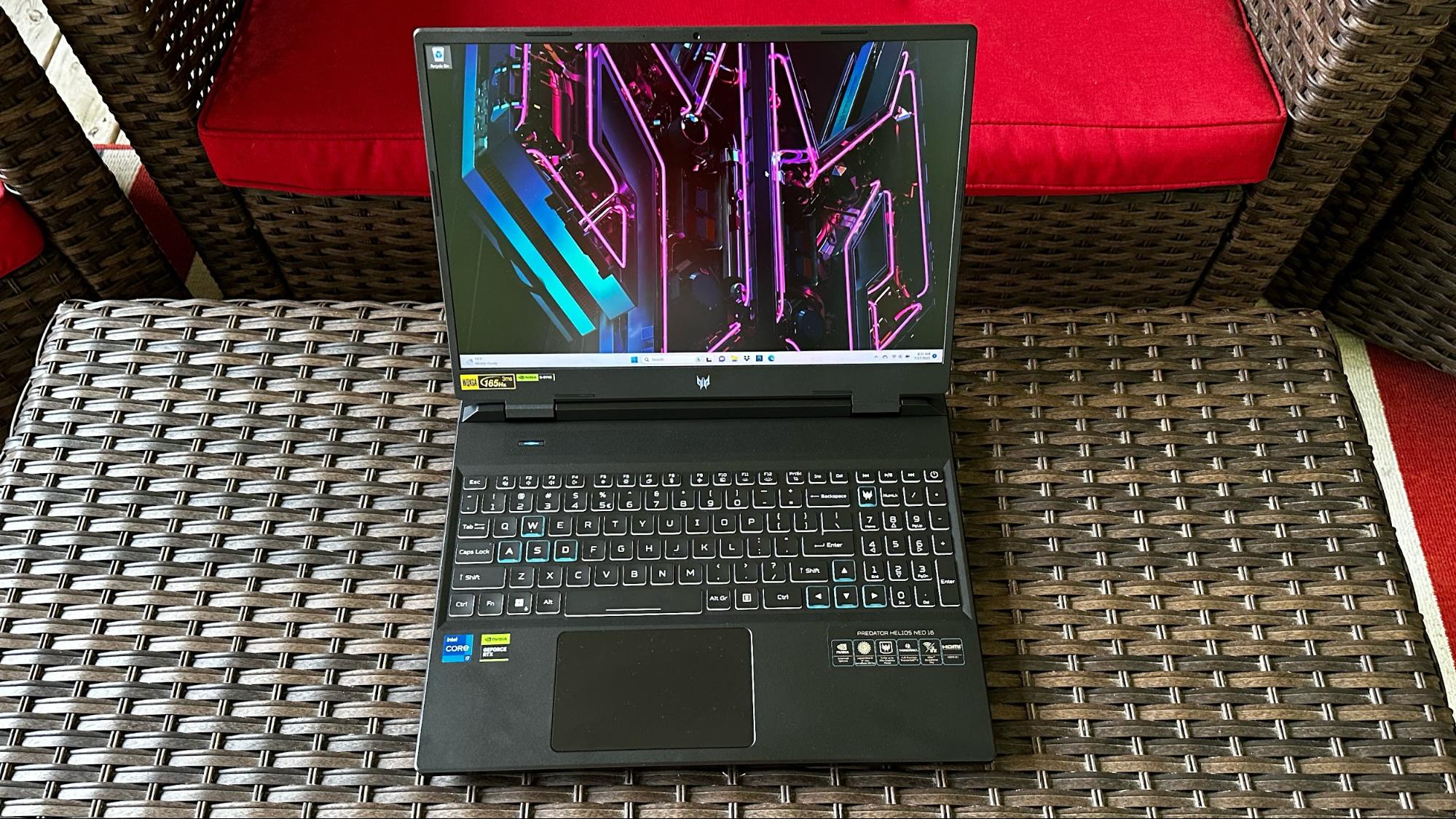
I’m always intrigued to see moderately-priced entries when looking for the best gaming laptops available on the market. While models loaded-to-the-gills with $2,000 (or higher!) price tags often pack tons of performance, gamers with more meager budgets are now awash with less expensive entries that offer a lot of bang for the buck.
With this in mind, that’s an all-new contender in the field, the Acer Predator Helio Neo 16, which offers an Intel Core i7-13700HX processor, Nvidia GeForce RTX 4060 GPU, 16GB of RAM, and a 16-inch QHD (2560 x 1440) display. It's not a budget system, but at $1,199 to start, $1,549 as tested, it's not unreasonable.
Acer wraps that hardware in a chassis that, while designed for 1440p gaming, wouldn’t look out of place in an office setting thanks to its restrained design.
Acer Predator Helios Neo 16 Specifications
Design of the Acer Predator Helios Neo 16
The Predator Helios Neo 16 is an all-new model for Acer, aimed explicitly at hitting a moderate price point for gamers. That said, I find the overall design very conservative and without much to stand out. The only elements of flash in the design are the WASD, arrow, and Predator Sense keys, which feature translucent blue keycaps topped in black versus the clear topped with black.
The black plastic chassis also has a slight shimmering effect when light hits it at certain angles. It’s subtle enough to add visual interest to the laptop without being in your face.

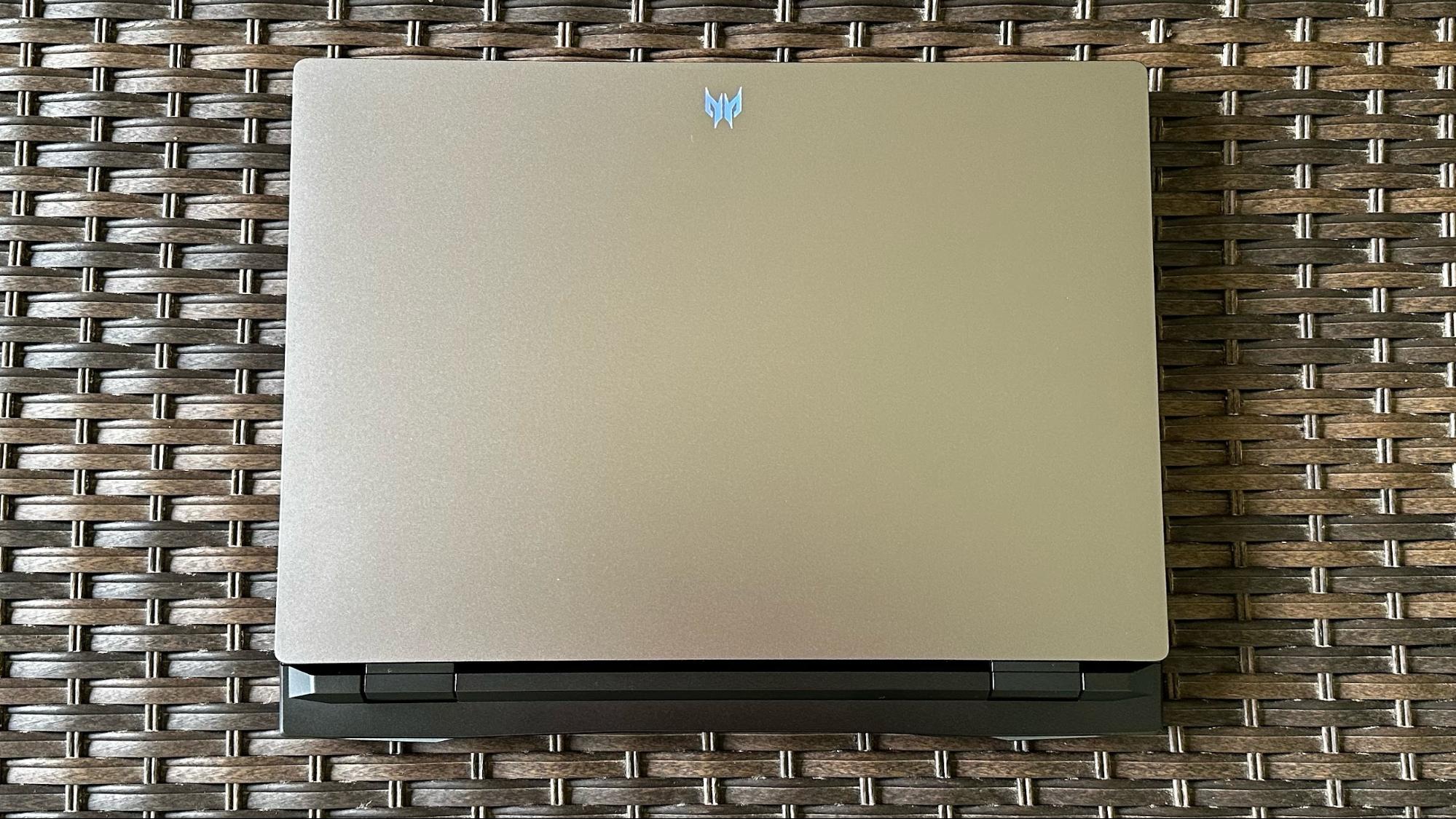
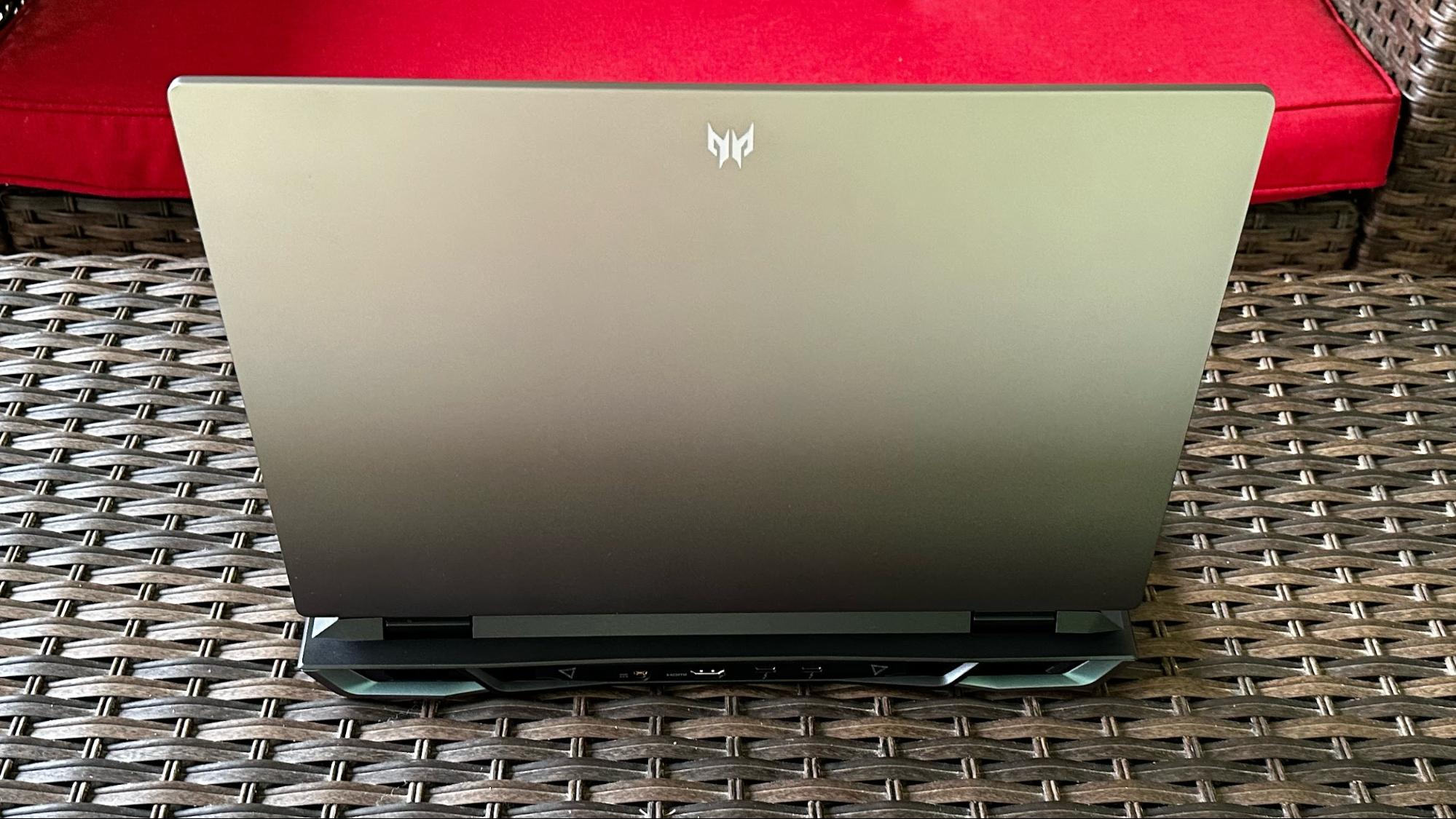
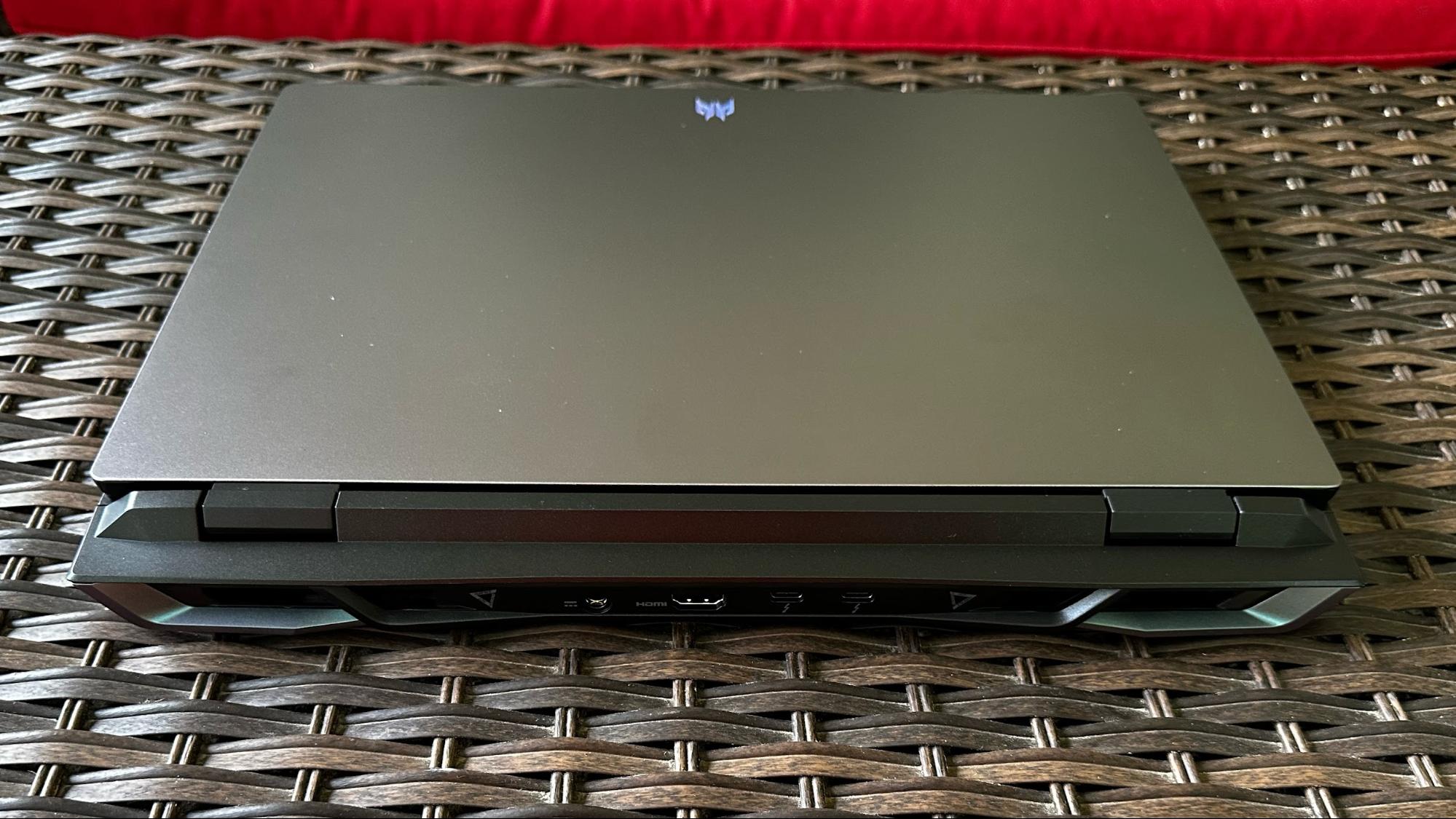
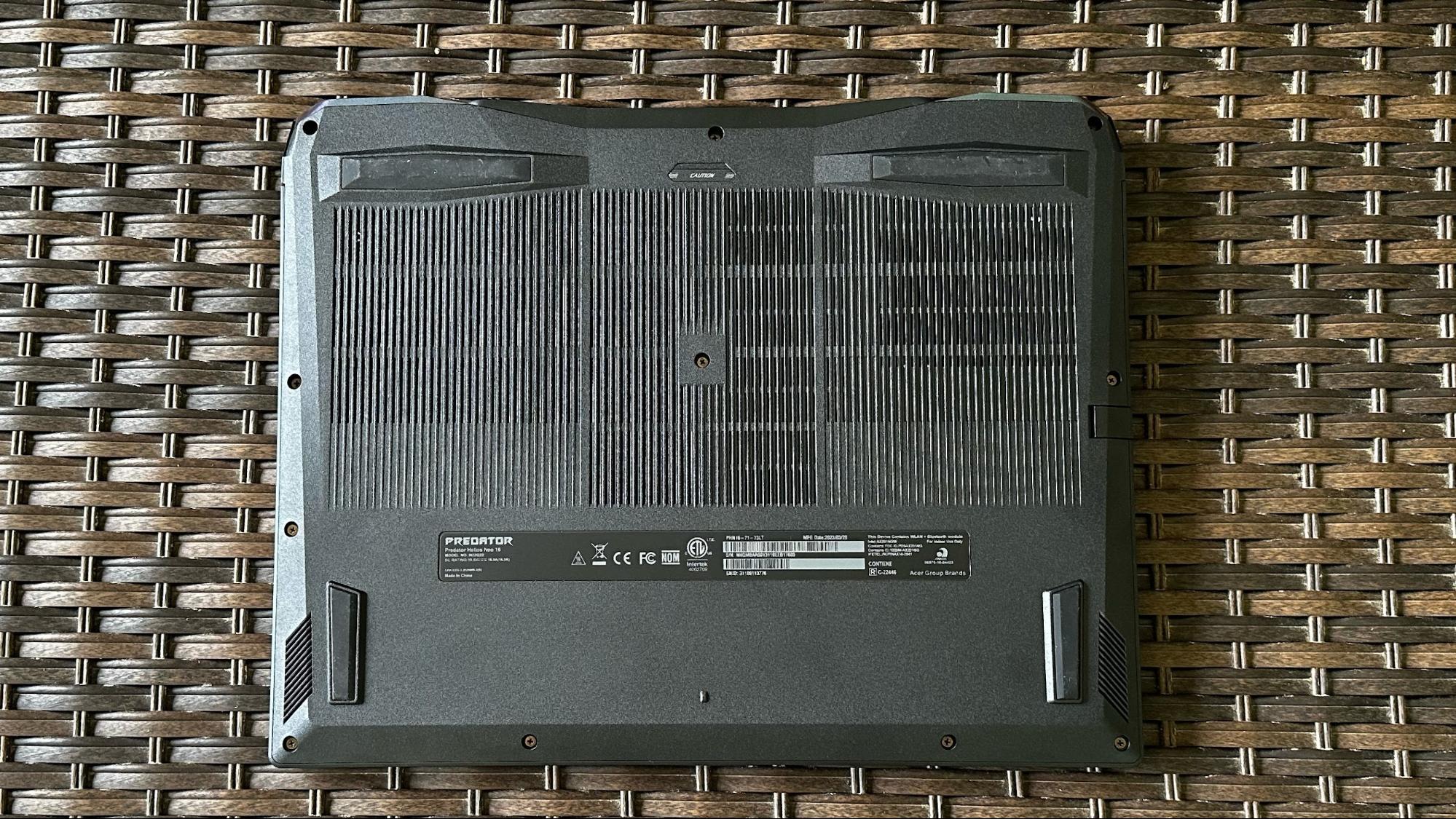
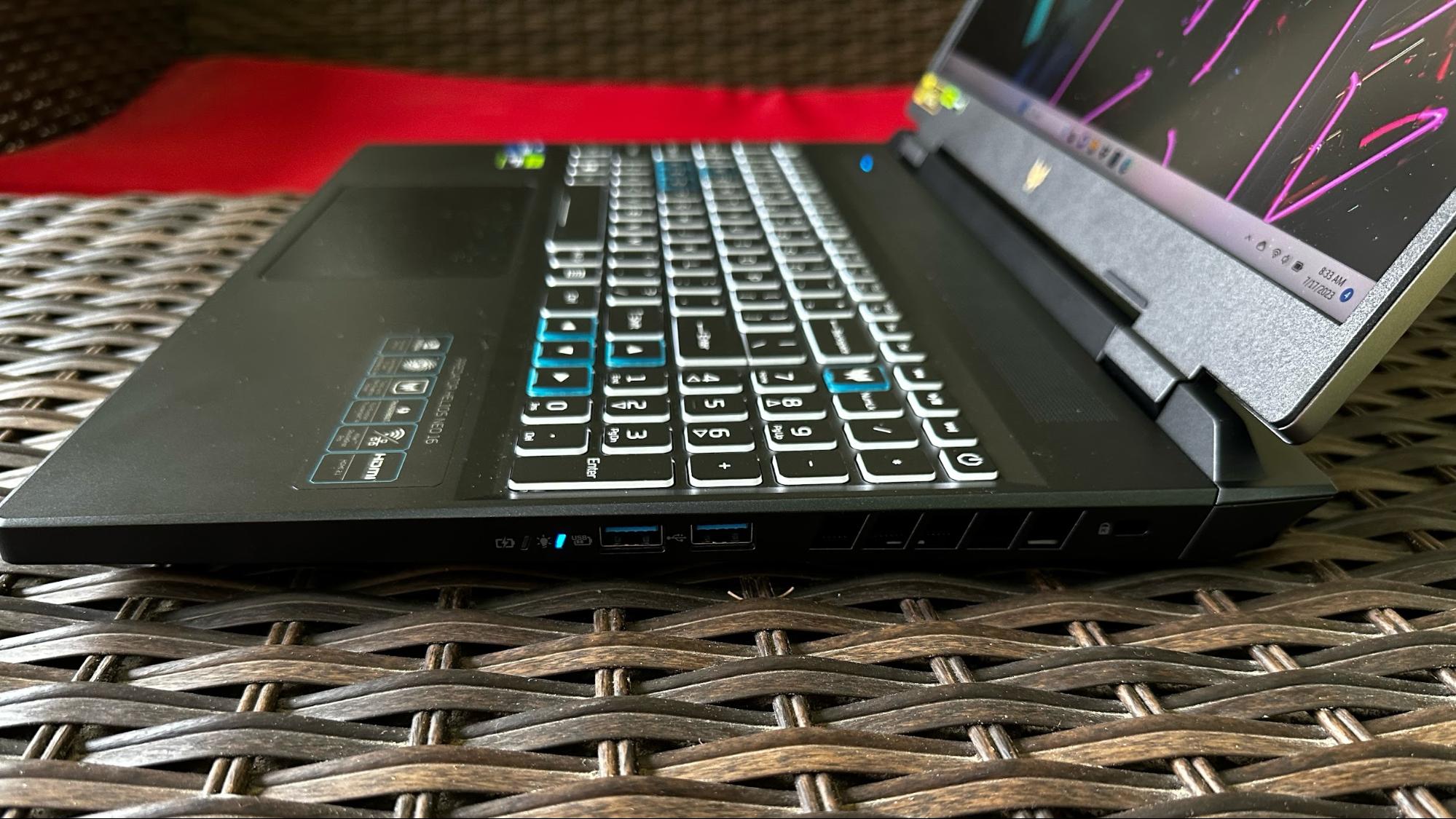

The 16-inch display has some thick bezels all around. The top bezel is roughly twice as wide as the sides, while the bottom bezel is massive. Acer attempts to break up the large visual expanse with a chromed Predator logo to little avail.
On the right side of the chassis, you find two USB 3.2 Gen 2 (Type-A) ports and a Kensington lock. Switching over to the left side, Acer includes a USB 3.1 Gen 2 (Type-A) port, an Ethernet jack, a MicroSD card reader slot and a 3.5 mm headphone jack. The back panel has an HDMI 2.1 port, two Thunderbolt 4 (Type-C) ports and a proprietary jack for the 330-watt power adapter.
The Predator Helios Neo 16 measures 14.18 x 11.02 x 1.05 inches and weighs 5.73 pounds. The Lenovo Legion Pro 5i and Gigabyte Aorus 15X are similar in dimensions and weight, while the Razer Blade 14, with a smaller display, was naturally sleeker at 12.23 x 8.97 x 0.70 inches and 4.05 pounds.
Gaming on the Acer Predator Helios Neo 16
The Predator Helios Neo 16 comes equipped with an Intel Core i7-13700HX CPU, Nvidia GeForce RTX 4060 GPU and 16GB of DDR5-4800 memory (2 x 8GB). The Core i7-13700HX has eight performance and eight efficiency cores and operates at a maximum turbo boost frequency of 5 GHz.
To kick off gaming testing with the Predator Helios Neo 16, I installed Cyberpunk 2077. I averaged 68 fps using high settings with ray tracing enabled, DLSS Balanced, and DLSS frame generation enabled at 1600p. Stepping down to 1200p, that figure rose to 90 fps.

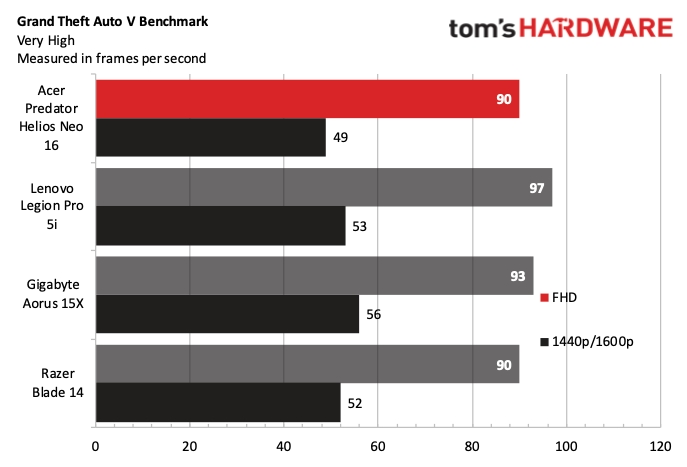
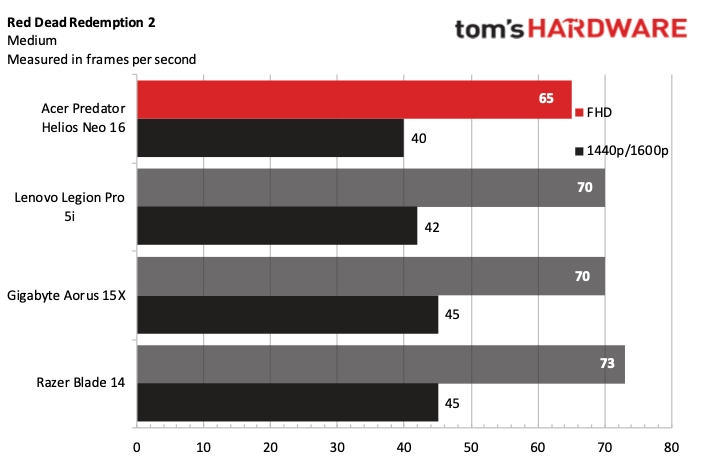
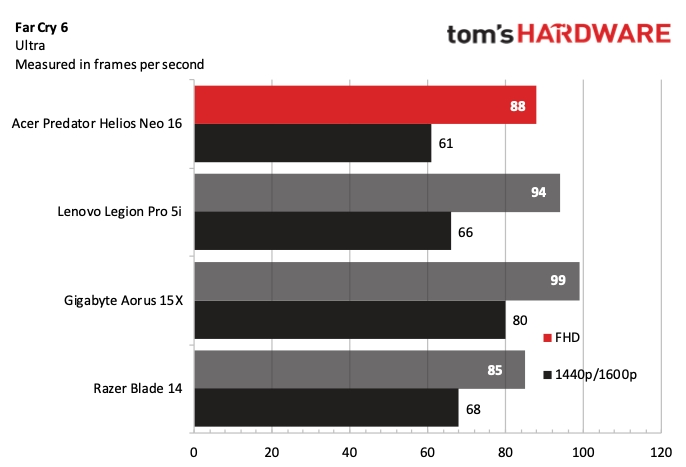
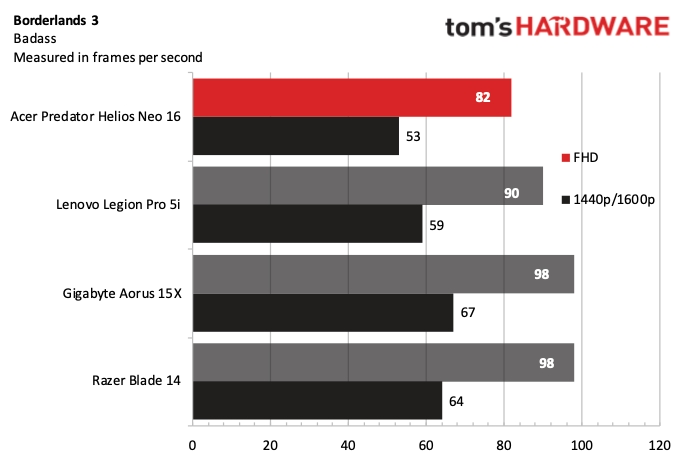
Moving to our usual suite of gaming benchmarks, I lined the Predator Helios Neo 16 up against the Lenovo Legion Pro 5i (i7-13700HX, RTX 4060, 1600p), Gigabyte Aorus 15X (i9-13900HX, RTX 4070, 1440p) and Razer Blade 14 (Ryzen 9 7940HS, RTX 4070, 1600p). Please note that the RTX 4070-based systems will have an edge in gaming benchmarks, while the RTX 4060 in the Legion Pro 5i has a slightly higher boost clock than the one in the Predator Helio Neo 16.
I started with Shadow of the Tomb Raider (highest settings), which saw the Predator Helios Neo 16 land in last place with 97 frames per second at 1080p and 57 fps at 1600p. The Legion Pro 5i with the same processor and GPU achieved 107 fps and 62 fps, respectively. That discrepancy is explained by the slightly lower vertical resolution of the Legion Pro 5i (1440p versus 1600p) and the higher boost clock (2370 MHz vs 2250 MHz). The Aorus 15X leads all systems with 115 fps at 1080p and 73 fps at 1440p.
Next, I queued up Grand Theft Auto V (very high settings), where the Predator Helios Neo 16 tied for third place with the Blade 14 at 1080p with 90fps. However, its showing at 1600p puts it in last place at 49 fps compared to 52 fps for the Blade 14. The Legion Pro 5i took home the gold with 97 fps at 1080p and hit 53 fps at 1440p.
The Aorus 15X slipped into first place in Far Cry 6 (ultra settings) with 99 fps at 1080p and 80 fps at 1440p. The Legion Pro 5i took second place, while the Predator Helio Neo 16 landed in third place, with 88 fps at 1080p and 61 fps at 1600p.
Red Dead Redemption 2 (medium settings) once again saw the Predator Helios Neo 16 in last place with 65 fps/40 fps (1080p/1440p). However, only 8 fps separated first and last place at 1080p, while the difference at 1600p was just 5 fps.
Moving to Borderlands 3 (badass settings), the Predator Helios Neo 16 could only muster 82 fps at 1080p and 53 fps at 1600p. The Aorus 15X hit 98 fps at 1080p, and managed 67 fps at 1440p.
To round out our benchmarks, we ran the Metro Exodus benchmark (RTX settings) through 15 loops at 1600p resolution. The benchmark ran at an average of 53.08 fps (consistently ranging between 52.76 to 53.19 fps). During the run, the Core i7-13700HX performance cores averaged 2.19GHz, while the efficiency cores averaged 1.82GHz at 65.7 degrees Celsius (150.3 degrees Fahrenheit). The GeForce RTX 4060 GPU ran at an average of 2.29 GHz and measured 73.2 C (163.8 F).
Productivity Performance on the Acer Predator Helios Neo 16
The Predator Helio Neo 16 features an Intel Core i7-13700HX CPU, 16GB of DDR5-4800 memory (2 x 8GB) and a 1TB PCIe 4.0 SSD.
Our Predator Helios Neo 16 review unit achieved scores of 1,880 and 14,625 in single- and multi-core performance, respectively, in Geekbench 5. Not surprisingly, those numbers were remarkably close to the Legion Pro 5i, which uses the same processor. The Aorus 15X, with its stronger Core i9-13900HX, took top honors with a single-core score of 2,007 and a multi-core score of 18,129.
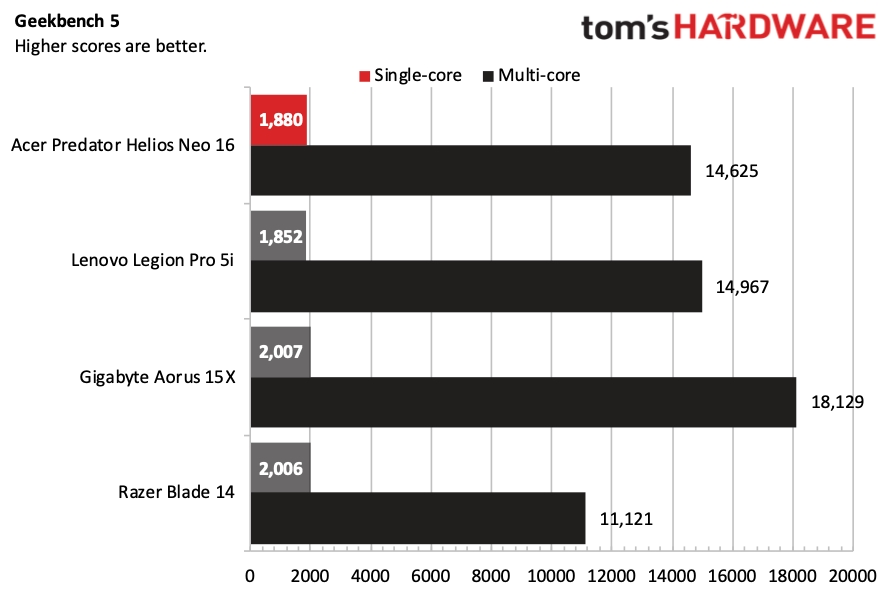
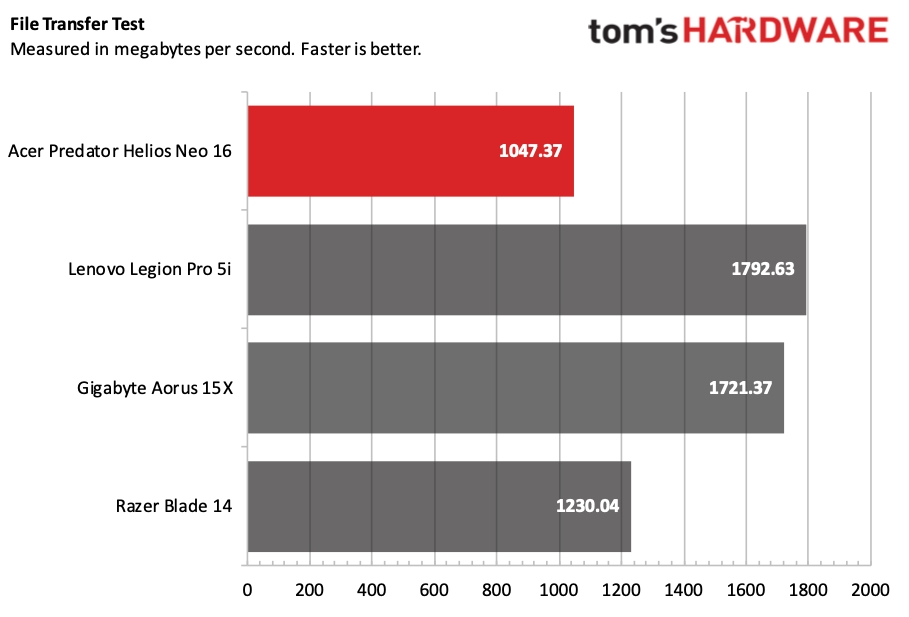
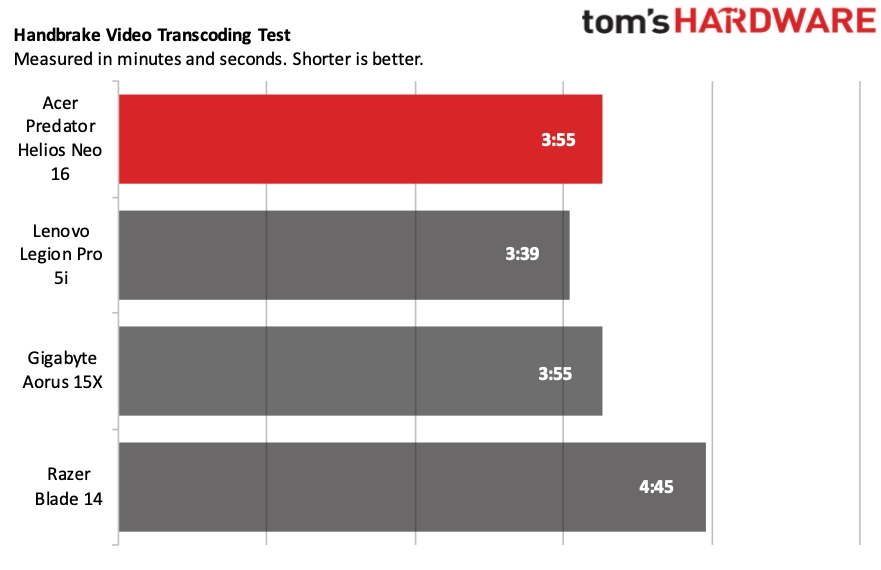
The Predator Helios Neo 16 came up well short against the competition in our 25GB file transfer test. The laptop hit 1,047.37 MBps compared to 1,230.04 for the third-place Blade 14. However, the Legion Pro 5i took first place with 1,792.63 MBps.
Finally, the Handbrake transcoding test saw the Predator Helios Neo 16 tied for second place at three minutes and 55 seconds, compared to three minutes and 39 seconds for the first-place Legion Pro 5i.
Display on the Acer Predator Helios Neo 16
The PredatDisplay on the Acer Predator Helios Neo 16or Helios Neo 16 uses a 16-inch IPS panel with a QHD+ (2560 x 1600) resolution and a 165Hz refresh rate. The panel is driven by an Nvidia GeForce RTX 4060 GPU.
16 inches is becoming a popular size for gaming notebooks. 15.6 inches was once the norm, but we’re seeing more laptops adopt 16-inch panels, specifically with a QHD+ resolution. As far as displays go, the IPS panel in the Predator Helios Neo 16 is highly capable. The anti-glare coating muted reflections in almost every possible situation except direct sunlight.
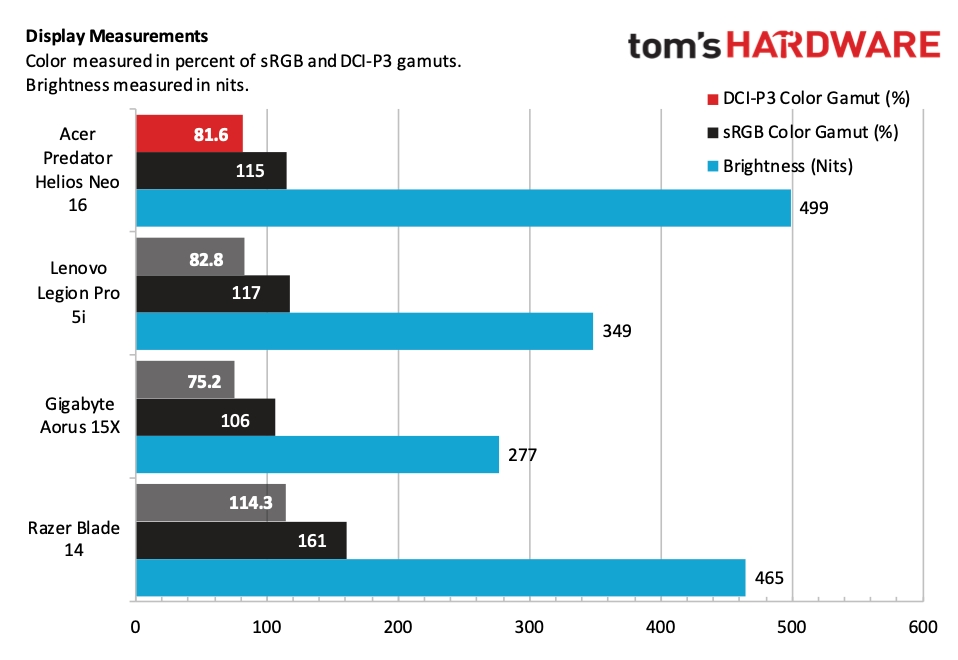
The Predator Helios Neo 16’s panel also gets incredibly bright, hitting 499 nits according to our light meter, which is right at the factory's claim of 500 nits. Instrumented testing with a colorimeter showed that the Predator Helios Neo 16 closely matched the Legion Pro 5i with 81.6 and 115 percent coverage of DCI-P3 and sRGB, respectively.
I watched the Oppenheimer trailer on YouTube in 1080p Premium HD (Enhanced Bitrate) and was impressed with the gritty look and feel. If you know Christopher Nolan films, you’re familiar with the muted colors and realistic tones compared to the more vibrant palettes you’d see in, say, the typical Marvel film.
Switching gears completely, I played the Barbie trailer which had just enough pink plastered throughout for me to reflexively reach for a bottle of Pepto Bismol. The blue of Barbie’s blazer and light blue skies of Malibu Beach also popped on the screen. Perhaps it’s time for a Barbenheimer double feature?
I also played quite a bit of Cyberpunk 2077, which looks gorgeous with the details cranked to high and with ray tracing enabled. The fine particles of smoke wafting through the air, the mirror-esque reflections in water, and the way that red light diffused inside bars looked terrific. The same could be said for vehicles and how the sunlight glistens on the chrome trim.
Keyboard and Touchpad on the Acer Predator Helios Neo 16
Given the price point, you won’t find a fancy mechanical keyboard on the Predator Helios Neo 16. However, the keyboard has nicely spaced keys and is comfortable to type on. Acer even found enough room to fit in a number pad (for those who like that added functionality).
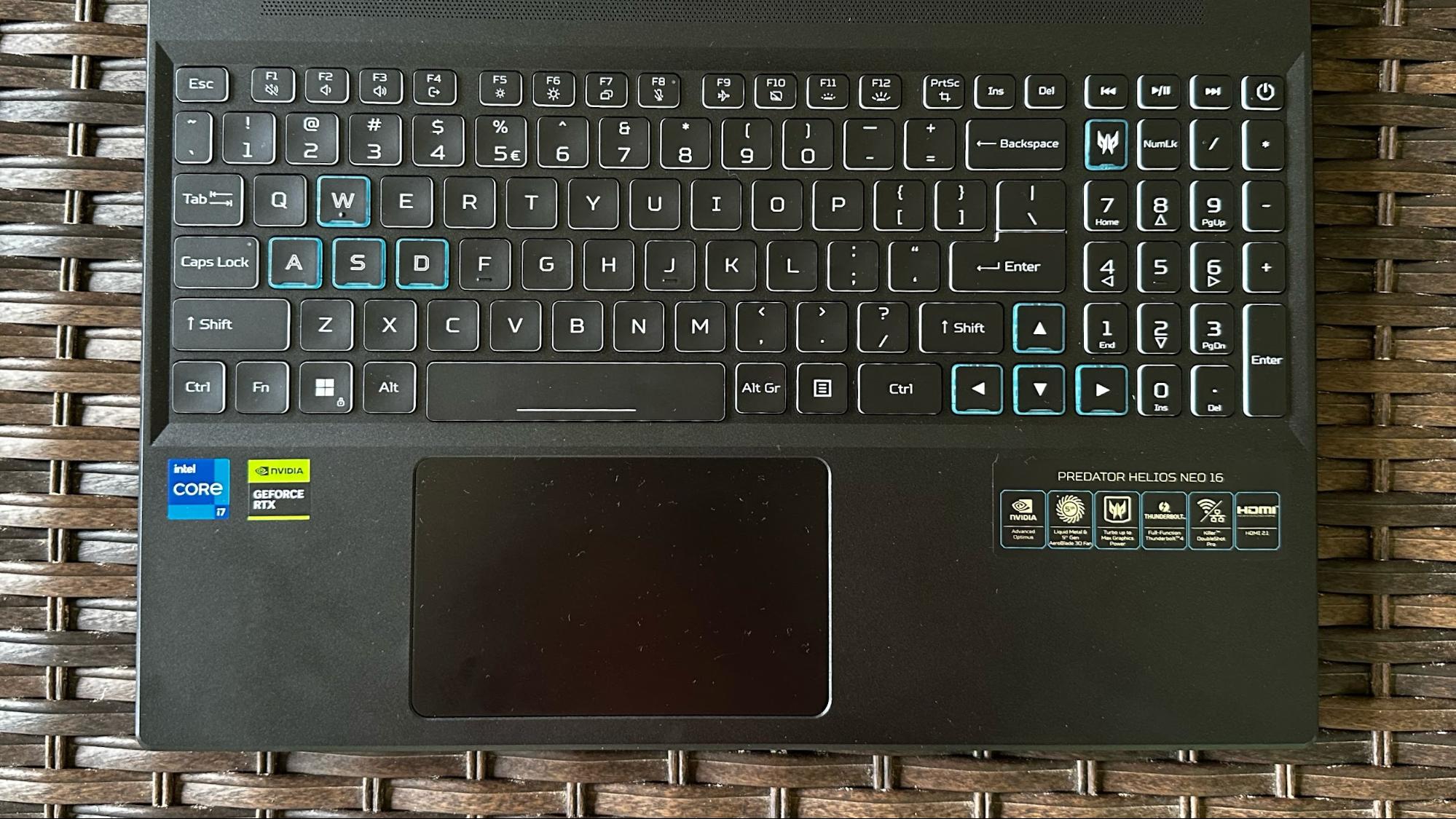
As usual, I leverage keyhero.com to gauge my typing speed and accuracy. I typed an average of 80 words per minute with an accuracy of 95.55 percent. For comparison, I achieved 90 wpm and 94 percent accuracy with the Razer Blade 14.
Acer includes its PredatorSense app for configuring the RGB lighting on the Predator Helios Neo 16. The laptop doesn’t feature per-key lighting but instead employs a four-zone arrangement. You can select any hue that you want for each of the four zones, and there are eight different lighting effects that you can choose.
There’s also a reasonably-sized touchpad, which measures 4.9 x 3.1 inches. My finger glided smoothly over the plastic surface and it had a satisfying click when pressed.
Audio on the Acer Predator Helios Neo 16
The Predator Helios Neo 16 uses stereo speakers with DTS:X Ultra Audio and Acer TrueHarmony. Acer claims that TrueHarmony, which refers to the foam-coated paper cones in the speaker, helps “maximize clarity” and “lower distortion” for more immersive sound.
In practice, the speakers sounded fine, at best. “Cracker Island” by the Gorillaz sounded lifeless, with no bass and muffled voices. The biggest detractor was increased distortion as I approached around 75 percent volume. Fiddling with settings in the Realtek Audio Console and the DTS:X Ultra apps had little effect on the sound.
While playing Grand Theft Auto V, things were more palatable, with explosions and firefights coming through loud and clear. And love him or hate him, hearing Trevor’s gravelly voice still made me smile a decade after he first appeared.
Upgradeability on the Acer Predator Helios Neo 16
Accessing the internals of the Predator Helios Neo 16 is accomplished by removing 11 Philips head screws. Then the whole bottom panel is easily removed using some well-placed fingernails.
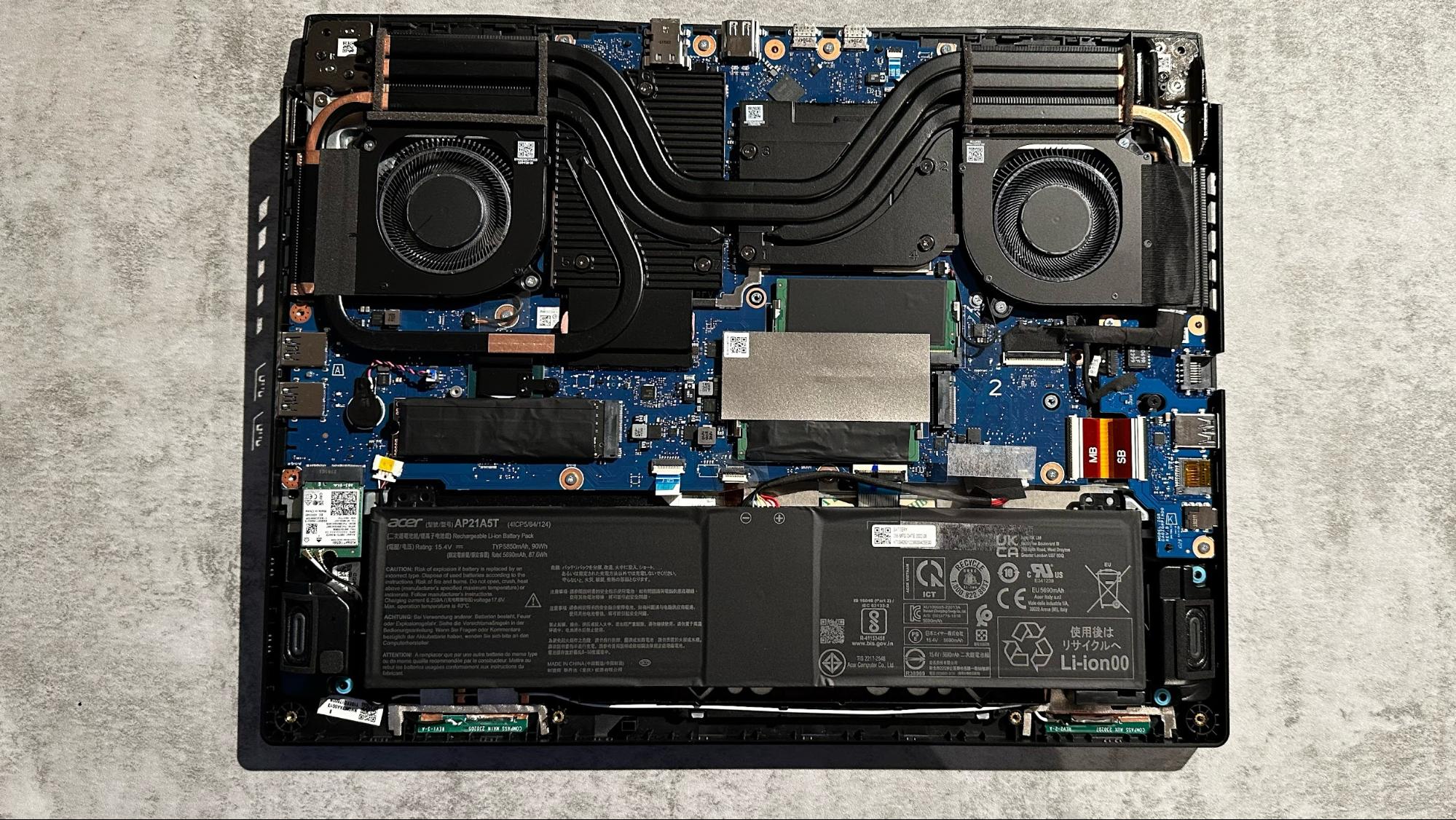
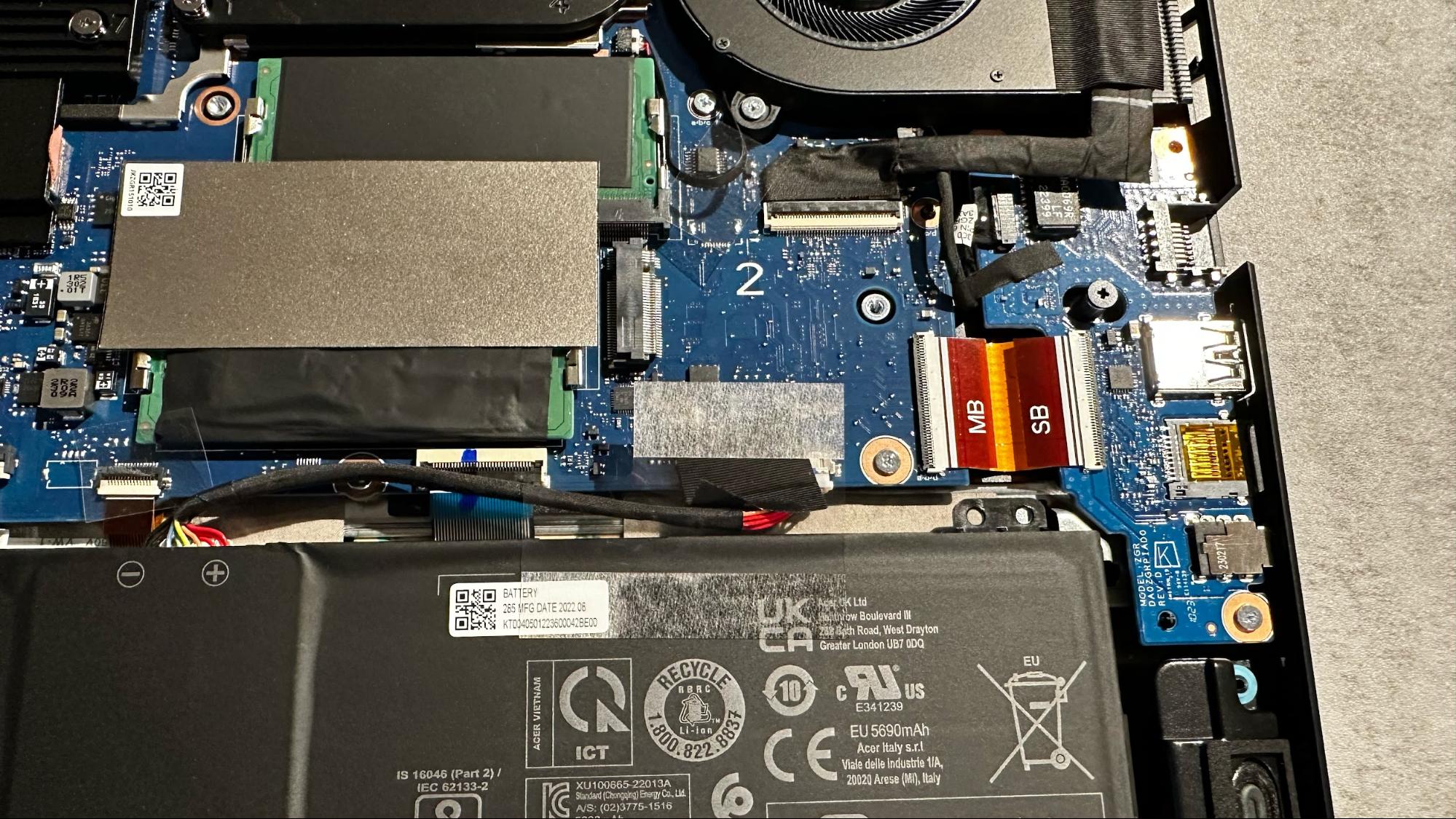
With the bottom panel removed, you can access the battery, two SO-DIMM slots (each occupied with 8GB DDR5-4800 modules in our review unit), and two M.2 slots. One of the M.2 slots holds the 1TB PCIe 4.0 SSD, while one is free for future expansion. There’s another slot for the M.2 Wi-Fi/Bluetooth combo card.
Battery Life on the Acer Predator Helios Neo 16
As I saw in the gaming benchmarks, the Predator Helio Neo 16 is near the back of the pack in overall performance. I hoped that the meager gaming results would result in above-average battery endurance. However, I was wrong. The Predator Helios Neo 16 lasted just shy of three hours (2:59) on our battery test, which browses the web, streams videos, and runs OpenGL graphics tests.

The next closest competitor was the Legion Pro 5i (4:54) and then the Aorus 15X (5:20). The Blade 14 outlasted all the assembled laptops with a runtime of 8:34. The Predator Helios Neo 16 uses a relatively beefy 90 WHr battery, which made the results even more puzzling.
Heat on the Acer Predator Helios Neo 16
The Predator Helios Neo 16 uses a Core i7-13700HX processor (55W) and a GeForce RTX 4060 GPU (140W). Acer employs dual fifth-generation AeroBlade 3D fans in the system and Liquid Metal thermal grease for the CPU.
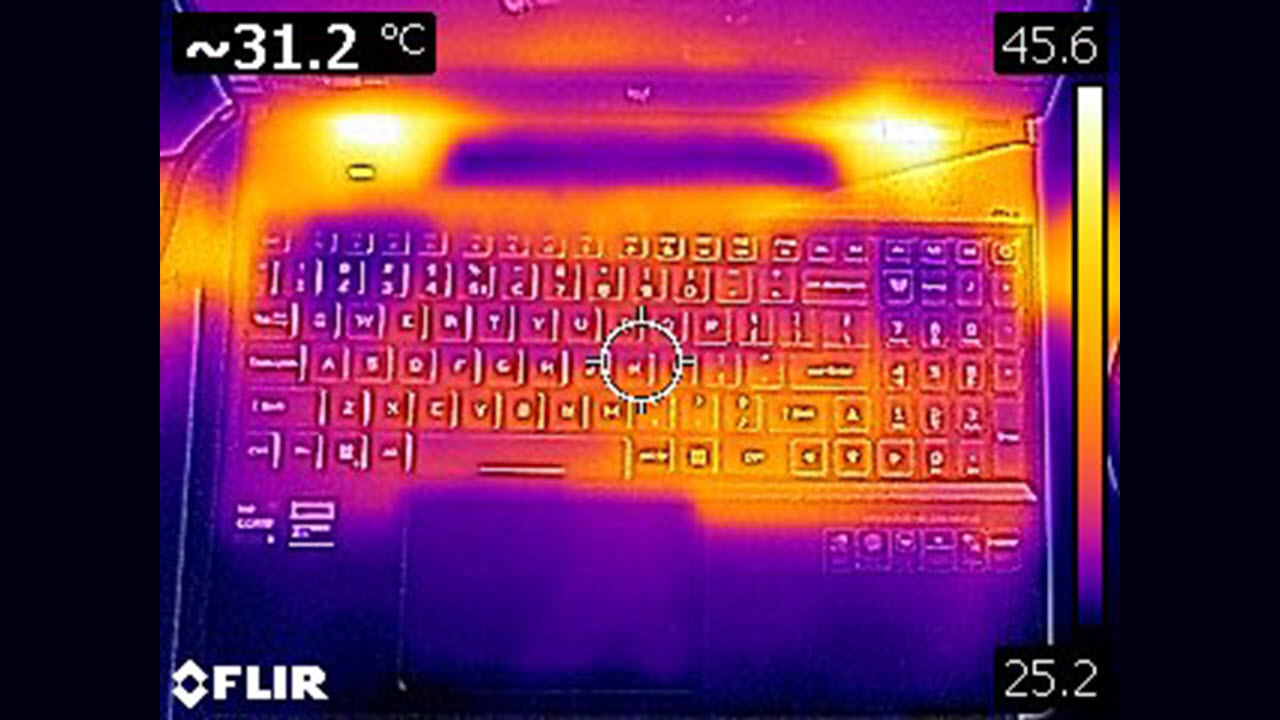
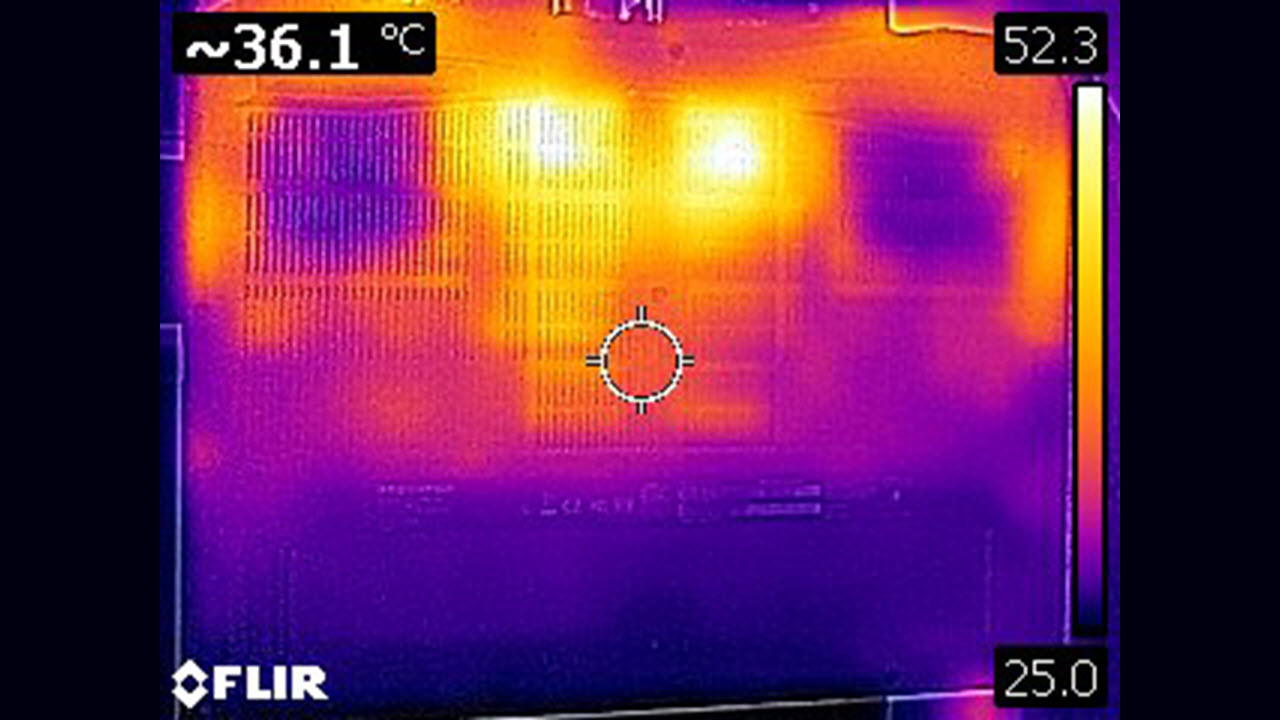
In testing during our Metro Exodus stress test (15 consecutive runs), the Predator Helios Neo 16 measured 25.8 degrees Celsius (78.5 degrees Fahrenheit) on the touchpad and 35.3 C (95.5 F) between the G and H keys. The underside of the laptop, which was also the hottest, measured 41.4 C (106.5 F) near the center.
Webcam on the Acer Predator Helios Neo 16
The Predator Helios Neo 16’s webcam is situated directly above the display, center stage. Acer uses a 1080p sensor, which has become commonplace in most new gaming notebooks but lacks a privacy shutter or Windows Hello facial recognition technology.
While not as good as some of the best webcams available, the Predator Helios Neo 16’s 1080p webcam had good detail and accurately captured my skin color. It also had no trouble capturing detail from my mustache and stubble on my face.
Software and Warranty on the Acer Predator Helios Neo 16
The Predator Helios Neo 16 is loaded with bloatware from the factory, which many customers will rarely use. You’ll Acer Purified Voice Control, Acer Product Registration, Acer Care Center (system vitals, recovery management, etc.), Acer Planet 9 (a social gaming platform), DTS Surround Unbound, DTS:X Ultra, Express VPN (30-day free trial), Dropbox (100GB free offer when you sign up for Acer customers), the Killer Intelligence Center and the Realtek Audio Console.
In addition to all those preinstalled apps, the usual Windows 11 bloatware is included, like shortcuts for Spotify, TikTok, ESPN, and Instagram.
However, the app that I used the most was Acer PredatorSense. This utility has its own dedicated key on the keyboard for easy access and allows you to set power profiles, adjust system fan speeds, and control the RGB lighting for the keyboard (among other things). It also allows you to monitor system vitals like fan speed, CPU/GPU temperature, Wi-Fi statistics and RAM speed/utilization.
The Predator Helios Neo 16 comes with a one-year warranty.
Acer Predator Helios Neo 16 Configurations
The Predator Helios Neo 16 base configuration has a Core i7-13500HX processor, GeForce RTX 4050, 16GB of RAM, a 512GB SSD and a 16-inch FHD+ display for $1,199. The mid-range configuration swaps out the RTX 4050 for an RTX 4060 and adds $100 to the price.
Our review unit came configured with a Core i7-13700HX processor, GeForce RTX 4060, 16GB of RAM, a 1GB SSD and a 16-inch QHD+ display for $1,549 and is available exclusively from Best Buy.
Bottom Line
The Acer Predator Helios Neo 16’s lower gaming numbers are easy to explain with the higher-performing GeForce RTX 4070 GPUs on two of the competitors. In addition, the Lenovo Legion Pro 5i features the same Core i7-13700HX CPU and RTX 4060 GPU, albeit with a slightly higher boost clock. So it’s not a surprising result.
However, when you add the low storage performance and the disappointing battery, which lasted just under three hours, it becomes harder to recommend the laptop.
The Predator Helios Neo 16 has some positives, like its bright display and attractive chassis. But it’s hard to overlook its performance shortcomings and, especially, its battery life. The final knock against the laptop is its price; at $1,549, the Legion Pro 5i represents a better option for $100 less.
MORE: How to Buy a Gaming Laptop
MORE: Best Gaming PCs







